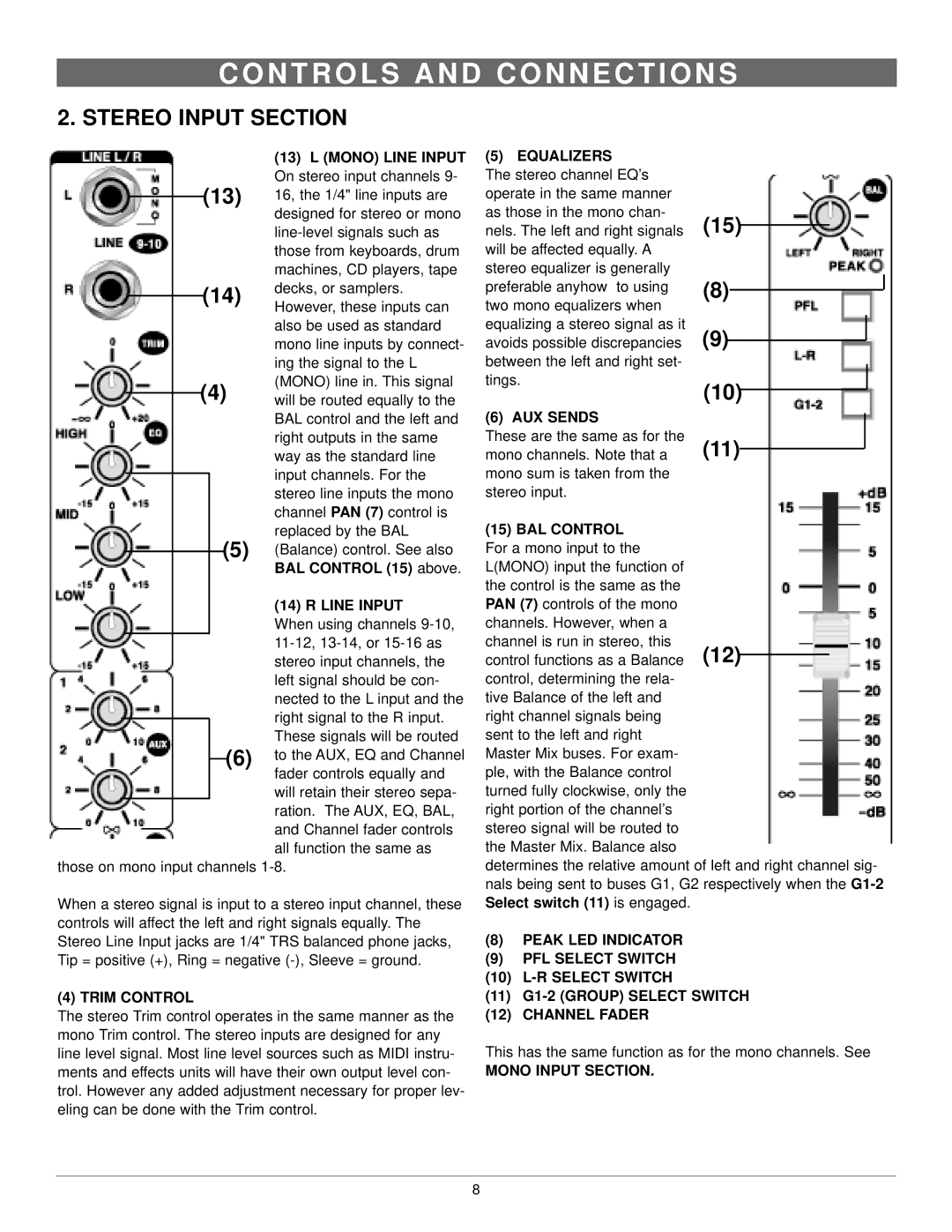
C O N T R O L S A N D C O N N E C T I O N S
2.STEREO INPUT SECTION
(13)L (MONO) LINE INPUT On stereo input channels 9-
(13)16, the 1/4" line inputs are designed for stereo or mono
(14)decks, or samplers. However, these inputs can
also be used as standard mono line inputs by connect- ing the signal to the L (MONO) line in. This signal
(4)will be routed equally to the BAL control and the left and right outputs in the same way as the standard line input channels. For the stereo line inputs the mono channel PAN (7) control is replaced by the BAL
(5)(Balance) control. See also BAL CONTROL (15) above.
(14)R LINE INPUT
When using channels
(6) to the AUX, EQ and Channel fader controls equally and will retain their stereo sepa- ration. The AUX, EQ, BAL, and Channel fader controls all function the same as
those on mono input channels
When a stereo signal is input to a stereo input channel, these controls will affect the left and right signals equally. The Stereo Line Input jacks are 1/4" TRS balanced phone jacks, Tip = positive (+), Ring = negative
(4) TRIM CONTROL
The stereo Trim control operates in the same manner as the mono Trim control. The stereo inputs are designed for any line level signal. Most line level sources such as MIDI instru- ments and effects units will have their own output level con- trol. However any added adjustment necessary for proper lev- eling can be done with the Trim control.
(5) EQUALIZERS |
|
|
|
|
|
|
|
|
The stereo channel EQ’s |
|
|
|
|
|
|
|
|
operate in the same manner |
|
|
|
|
|
|
|
|
as those in the mono chan- | (15) |
|
|
|
|
| ||
nels. The left and right signals |
|
|
|
|
| |||
|
|
|
|
| ||||
will be affected equally. A |
|
|
|
|
|
|
|
|
stereo equalizer is generally |
|
|
|
|
|
|
|
|
preferable anyhow to using | (8) |
|
|
|
|
|
| |
|
|
|
|
|
| |||
two mono equalizers when |
|
|
|
|
|
|
|
|
equalizing a stereo signal as it | (9) |
|
|
|
|
|
|
|
avoids possible discrepancies |
|
|
|
|
|
|
| |
|
|
|
|
|
|
| ||
between the left and right set- |
|
|
|
|
|
|
|
|
|
|
|
|
|
|
|
| |
tings. | (10) |
|
|
| ||||
(6) AUX SENDS |
|
|
| |||||
|
|
|
|
|
|
|
| |
|
|
|
|
|
|
|
| |
These are the same as for the | (11) |
|
|
|
| |||
mono channels. Note that a |
|
|
| |||||
|
|
| ||||||
mono sum is taken from the stereo input.
(15)BAL CONTROL For a mono input to the L(MONO) input the function of the control is the same as the PAN (7) controls of the mono channels. However, when a channel is run in stereo, this
control functions as a Balance (12) control, determining the rela-
tive Balance of the left and right channel signals being sent to the left and right Master Mix buses. For exam- ple, with the Balance control turned fully clockwise, only the right portion of the channel’s stereo signal will be routed to the Master Mix. Balance also
determines the relative amount of left and right channel sig- nals being sent to buses G1, G2 respectively when the
(8)PEAK LED INDICATOR
(9)PFL SELECT SWITCH
(10)L-R SELECT SWITCH
(11)G1-2 (GROUP) SELECT SWITCH
(12)CHANNEL FADER
This has the same function as for the mono channels. See
MONO INPUT SECTION.
8
